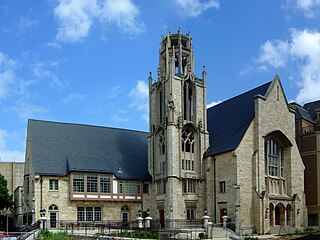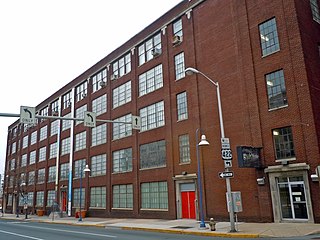
The First Unitarian Society of Madison (FUS) is a Unitarian Universalist congregation in Shorewood Hills, Wisconsin. Its meeting house was designed by Frank Lloyd Wright and built by Marshall Erdman in 1949–1951, and has been designated a U.S. National Historic Landmark for its architecture. With over 1,000 members, it is one of the ten largest Unitarian Universalist congregations in the United States.

Bascom Hill is the iconic main quadrangle that forms the historic core of the University of Wisconsin–Madison campus. It is located on the opposite end of State Street from the Wisconsin State Capitol, and is named after John Bascom, former president of the University of Wisconsin.

St. Peter's Evangelical Lutheran Church, or Iglesia Luterana San Pedro, is a historic church complex located in the Walker's Point neighborhood of Milwaukee, Wisconsin. Its buildings are listed on the National Register of Historic Places.

The former First Church of Christ, Scientist, now the Little Rock Community Church, is a historic church building at 2000 South Louisiana Street in Little Rock, Arkansas. It is a single-story Mission style building, designed by noted Arkansas architect John Parks Almand and completed in 1919. Characteristics of the Mission style include the low-pitch tile hip roof, overhanging eaves with exposed rafter ends, and smooth plaster walls. The building also has modest Classical features, found in pilaster capitals and medallions of plaster and terra cotta. The building is local significant for its architecture. It was built for the local Christian Science congregation, which in 1950 sold it to an Evangelical Methodist congregation. That congregation has since severed its association with the Evangelical Methodist movement, and is now known as the Little Rock Community Church.

The former First Church of Christ, Scientist in Forest Grove, Oregon, United States, is a historic Christian Science church built in 1916. It was designed by Spencer S. Beman, son of the noted designer of Christian Science churches, Solon Spencer Beman who had died in 1914. On January 21, 1994, it was added to the National Register of Historic Places.

The Wayne State University historic district consists of three buildings on 4735-4841 Cass Avenue in Midtown Detroit, Michigan: the Mackenzie House, Hilberry Theatre, and Old Main, all on the campus of Wayne State University. The buildings were designated a Michigan State Historic Site in 1957 and listed on the National Register of Historic Places in 1978.

The former First Unitarian Church is a historic church building at 130 Highland Avenue in Somerville, Massachusetts. The stone church was built in 1894 for a Unitarian congregation. It was designed by Hartwell & Richardson and is a good example of Richardsonian Romanesque design. The building presently (2022) houses the Mission Church of Our Lord Jesus Christ.

Fifth Church of Christ, Scientist is an historic Classical Revival-style Christian Science church building located at 9 East 43rd Street near Madison Avenue and Grand Central Terminal in Manhattan, New York City. Built in 1921 on the former site of St. Bartholomew's Episcopal Church. Fifth Church of Christ, Scientist, is unusual in that it occupies part of the first two stories of a 21-story office building that was originally named the Canadian Pacific Building. The church auditorium seats 1800 people.

The former First Church of Christ, Scientist, is an historic Christian Science church building located at 700 22nd Street, Rock Island, Illinois, United States. Designed by architect William C. Jones of Chicago in the Palladian style, it was built between 1914-1915. Its exterior walls are of brick covered by Bedford limestone. Its superimposed front portico is supported by six 2 story columns with egg-and-dart capitals. Its dome actually consists of 2 domes: an outer dome and an inner dome which are separated by a space for lighting fixtures and maintenance. The inner dome consists of some 8,000 colored fish scale glass panes on a wooden support structure. The inner dome is similar to the inner dome of First Church of Christ, Scientist in Kalamazoo, Michigan, which was designed by William C. Jones in 1913.

The Eugene A. Gilmore House, also known as "Airplane" House, constructed in Madison, Wisconsin in 1908, is considered "a superb expression of Frank Lloyd Wright's mature Prairie school." The client, Eugene Allen Gilmore, served as a law professor at the nearby University of Wisconsin Law School. In 1973 the house was added to the National Register of Historic Places.

The former First Church of Christ, Scientist, built in 1907, is an historic Christian Science church edifice located at 1443–1451 North Prospect Avenue in Milwaukee, Wisconsin. It was designed in the Classical Revival style by noted Chicago architect Solon Spencer Beman, who designed at least a dozen other Christian Science churches across the country. On March 8, 1989, it was added to the National Register of Historic Places. Today it is occupied by 1451 Renaissance Place and is the venue for weddings and other social events as well as corporate events.

The former Sixth Church of Christ, Scientist, built in 1902, is an historic Christian Science church edifice located at 1036 North Van Buren Street in Milwaukee, Wisconsin. In 1980 the building was added to the National Register of Historic Places. On May 17, 1983, Sixth Church was made a locally designated historic site by the city of Milwaukee.

The Hebrew Tabernacle of Washington Heights is an historic domed Art Deco style building and Reform synagogue. It is located at 551 Fort Washington Avenue, on the corner of 185th Street, in the Washington Heights neighborhood of Manhattan in New York City.

The University Presbyterian Church and Student Center, nicknamed Pres House, is a historic church on State Street in Madison, Wisconsin, United States. Designed by a local architect in 1931, it was completed four years later in a Gothic Revival style.

Fulton Congregational Church is a historic church on Fulton Street in Fulton, Wisconsin, United States. It was built in 1858 and was added to the National Register of Historic Places in 1976.

First German Reformed Church was a historic church built in 1891 at 413 Wisconsin Avenue in Waukesha, Wisconsin, United States. It was added to the National Register of Historic Places in 1991. The 1891 building burned to the ground in 2005.

Muhlenberg Brothers was one of the dominant architecture/engineering firms in Reading, Pennsylvania during the first half of the 20th century.
St. Luke's Episcopal Church, formerly known as Hope Episcopal Church, is an historic church building located in Fort Madison, Iowa, United States. It is a parish church of the Episcopal Diocese of Iowa, and it is a contributing property in the Park-to-Park Residential Historic District listed on the National Register of Historic Places.
Frank M. Riley was an architect of Madison, Wisconsin. A number of his works are listed on the National Register of Historic Places for their architecture.

First Church of Christ, Scientist, Brisbane is a heritage-listed site at 273 North Quay, Brisbane City, City of Brisbane, Queensland, Australia. It was designed by Lucas and Cummings, Architects. It was added to the Queensland Heritage Register on 11 March 2016.





















